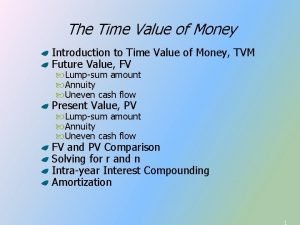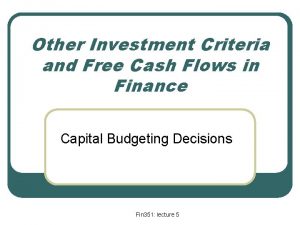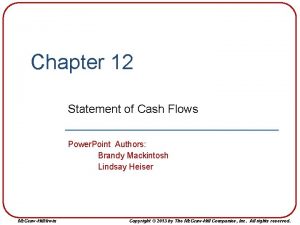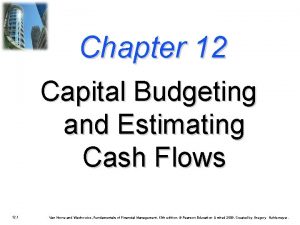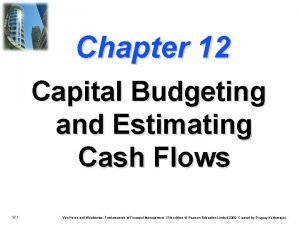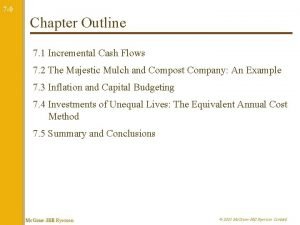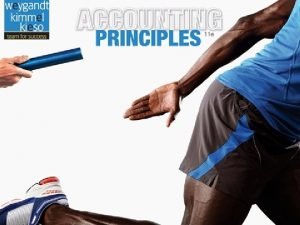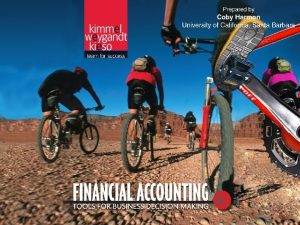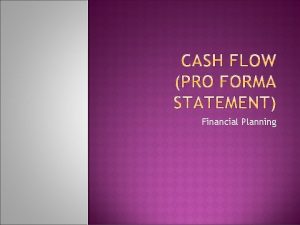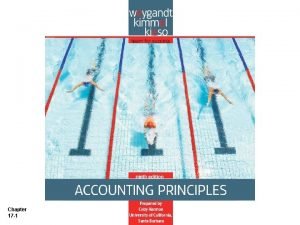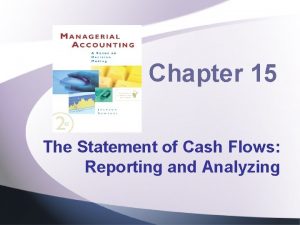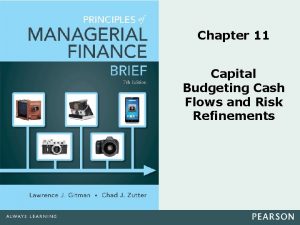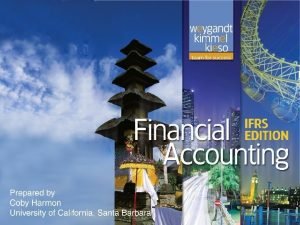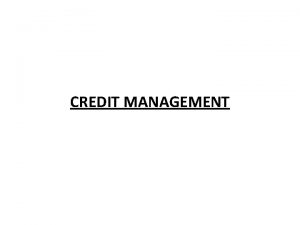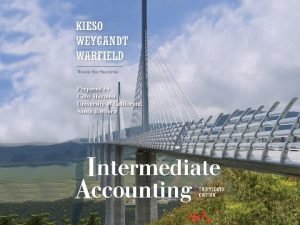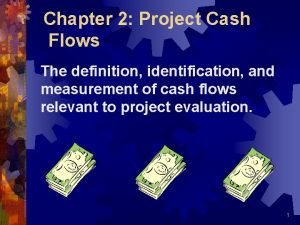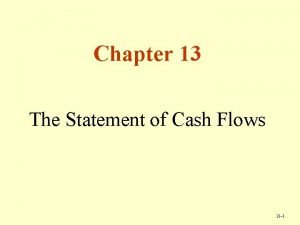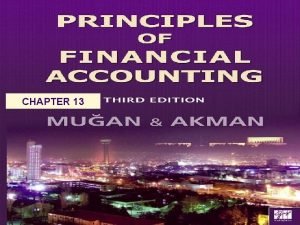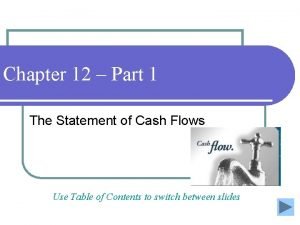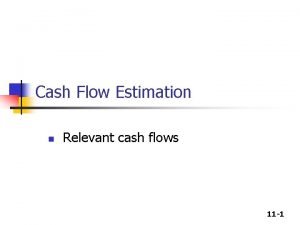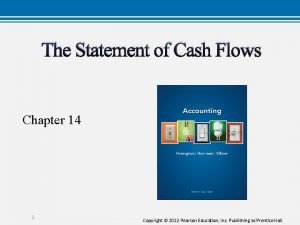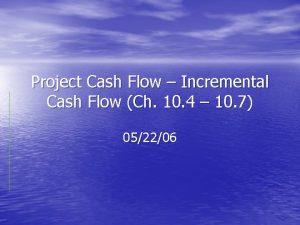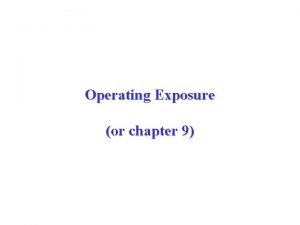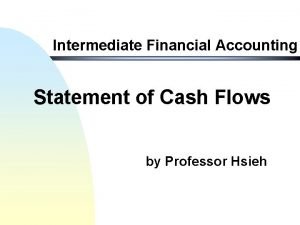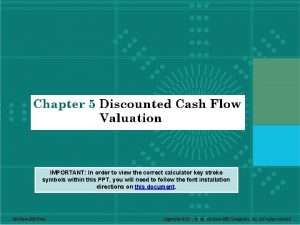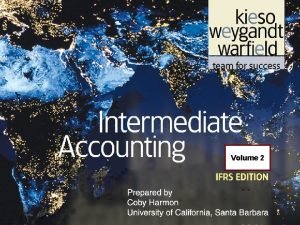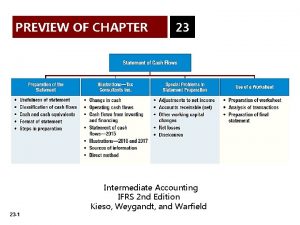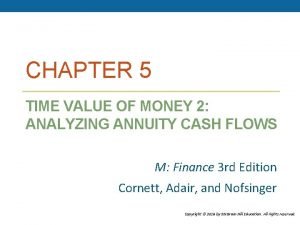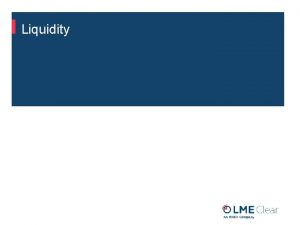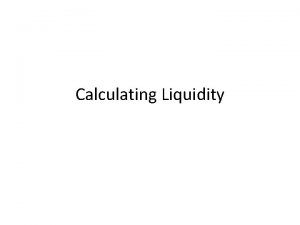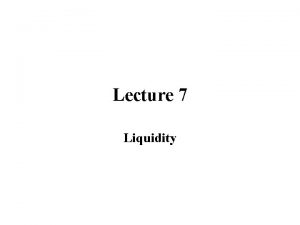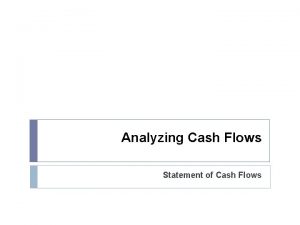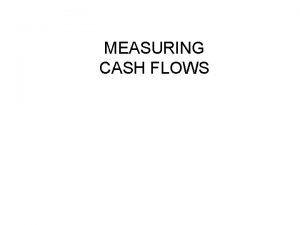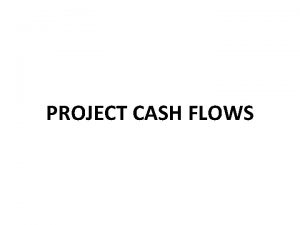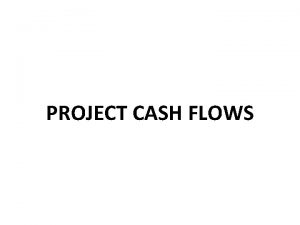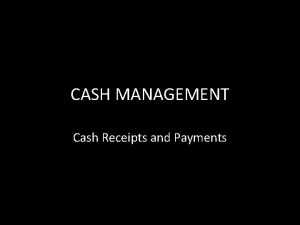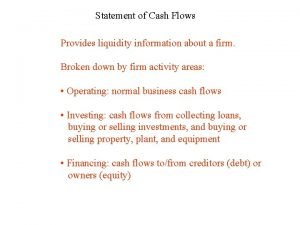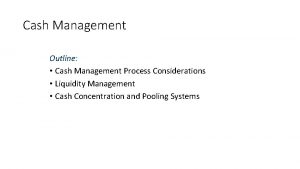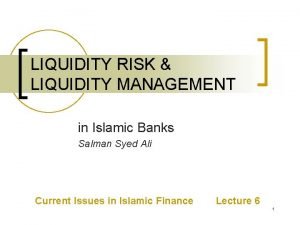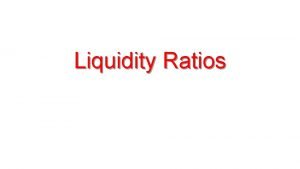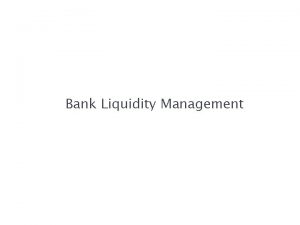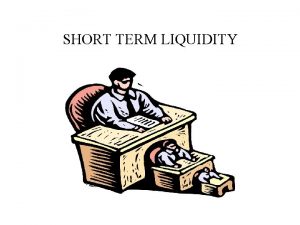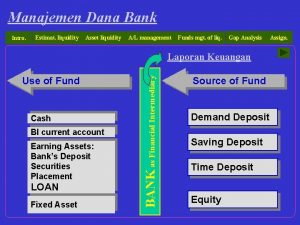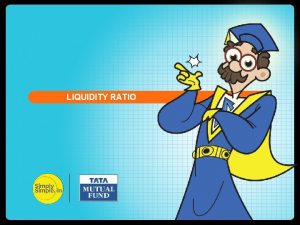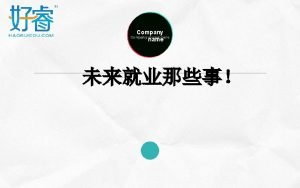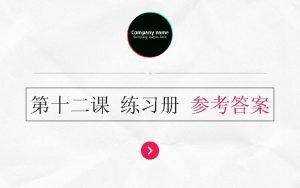USING CASH FLOWS TO EVALUATE COMPANY Liquidity Cash



































- Slides: 35


USING CASH FLOWS TO EVALUATE COMPANY • Liquidity – Cash current debt coverage ratio • Profitability – Cash return on sales ratio – Cash flow per share • Solvency – Cash total debt coverage These ratios are cash-based instead of accrual-based

CASH CURRENT DEBT COVERAGE • Cash current debt coverage indicates the amount of cash to pay off current debt that is generated from operating activities. • The ratio provides a better picture of liquidity than using the current ratio because it uses cash provided by operating activities rather than the year-end asset balance. Cash Provided by Operating Activities Average Current Liabilities Cash Current Debt Coverage

CASH RETURN ON SALES • Cash return on sales indicates how quickly sales are turned into cash. • The company is efficient at turning sales into cash when its cash return on sales is greater than its accrual-based counterpart, the profit margin. Cash Provided by Operating Activities Net Sales Cash Return on Sales

CASH FLOW PER SHARE • Cash flow per share indicates the cash flow generated for each common share. Cash Flow from Operating, Investing, and Financing Activities Number of Common Shares Cash Flow per Share

CASH TOTAL DEBT COVERAGE • Cash total debt coverage indicates the amount of cash to pay off total debt that is generated from operating activities. • The ratio is the cash based counterpart to the debt to total assets ratio. Cash Provided by Operating Activities Average Total Liabilities Cash Total Debt Coverage

Other Cash Flow Considerations • Generally, information on gross receipts and payments more relevant – When issuing long-term debt to retire other debt, show both • Noncash investing and financing – Acquiring plant assets by issuing notes payable – Converting bonds payable into common stock

Direct versus Indirect Method for Operating Activities • Direct shows major classes of gross cash receipts and cash payments – Difference is net cash provided by, used in, operating activities • Indirect starts with net income (loss) and adjusts for revenues and expenses that did not cause changes in cash • FASB encourages use of the direct method

Direct Method • Goal to convert each income statement item from accrual to cash basis • First, identify the balance sheet account(s) that relate to each income statement item • Next, combine the change in the balance sheet account with the income statement amount

Cash Receipts from Customers • Cash receipts from customers relates sales to change in accounts receivable • If accounts receivable decreased during the period, we collected more cash than amount reported as sales revenue • If accounts receivable increased during the period, we collected less cash that amount reported as sales revenue

Cash Receipts from Customers • Take sales amount and – Add decrease in accounts receivable – OR – Subtract increase in accounts receivable

Cash Payments to Suppliers • Cash Payments to Suppliers relates cost of goods sold to change in merchandise inventory and change in accounts payable • First use cost of goods sold and change in inventory to calculate purchases • If inventory increased during the period, we purchased more goods than we sold • If inventory decreased during the period, we purchased fewer goods than we sold

Cash Payments to Suppliers • To calculate purchases, take cost of goods sold amount and – Add increase in inventory – OR – Subtract decrease in inventory • This gives us accrual purchases

Cash Payments to Suppliers • Second use purchases and change in accounts payable to calculate cash payments to suppliers • If accounts payable increased during period, we paid less cash than purchases • If accounts payable decreased during period, we paid more cash than purchases

Cash Payments to Suppliers • To calculate cash payments to suppliers, take purchases amount and – Add decrease in accounts payable – OR – Subtract increase in accounts payable

Other Expenses That Affect Cash • Cash payments for expenses relate the expense to a change in an accrued expense account or a prepaid expense – Cash payments for wages relates wages expense and change in wages payable – Cash payments for office supplies relates office supplies expense and changes in office supplies

Other Expenses That Affect Cash • To calculate cash payments for expenses, take the expense amount and – Add decrease in accrued expense – OR – Subtract increase in accrued expense – OR – Add increase in prepaid expense – OR – Subtract decrease in prepaid expense

Other Revenues That Affect Cash • Cash receipts for revenues relate the revenue to a change in an unearned revenue account or accrued revenue – Cash receipts from interest relates interest revenue and change in interest receivable – Cash receipts from subscriptions relates subscriptions revenue and changes in unearned subscriptions

Other Revenues That Affect Cash • To calculate cash receipts from revenues, take the revenue amount and – Add decrease in accrued revenue – OR – Subtract increase in accrued revenue – OR – Add increase in unearned revenue – OR – Subtract decrease in unearned revenue

Indirect Method for Operating Activities • Starts with net income(loss) from the income statement. • Adjusts for revenues and expenses that did not cause a change in cash • Results in same total as direct method • FASB encourages use of direct • Believes that reconciliation of net income to cash provided by operations is useful information

Indirect Method Step 1 • Net income • Add – Expenses that did not use cash and losses on sale of noncurrent assets • Subtract – Gains on sales of noncurrent assets

Indirect Method Step 2 • Add – Decreases in operating current assets – Increases in operating current liabilities • Subtract – Increases in operating current assets – Decreases in operating current liabilities

Cash Flows from Investing Activities • Analyze changes in non-operating current assets and noncurrent assets – If equipment increased, there was a purchase of new equipment – If equipment decreased, there was a disposal of old equipment • If there was more than one change, analyze each separately • Identify the cash flow from each transaction

Cash Flows from Financing Activities • Analyze changes in nonoperating current liabilities, noncurrent liabilities, paid-in capital, and nonoperating changes to retained earnings(dividends) – If bonds increased, there was an issuance of bonds – If paid-in capital increased, there was an issuance of stock

Cash Flows from Financing Activities • If dividends were declared, combine amount declared with change in dividends payable to get cash dividends • If there was more than one change, analyze each separately • Identify the cash flow from each transaction

Steps in Preparing Statement of Cash Flows • Compute the net change in cash and cash equivalents • Compute the amount of net cash provided by (used in) operating activities by direct method • Prepare the reconciliation of net income to net cash provided by (used in) operating activities by indirect method

Steps in Preparing Statement of Cash Flows • Compute the amount of net cash provided by (used in) investing and financing activities • Prepare the statement of cash flows

Interpretation of Information in Statement of Cash Flows • Overall, how successful has management been in generating and investing cash flows during the period? • How does accrual net income compare with cash net income?

Interpretation of Information in Statement of Cash Flows • What cash uses have been made for investing activities and to what extent has cash from operations been sufficient to pay for these investments? • What sources and uses have been generated from financing activities?

Free Cash Flow § Free cash flow is the amount of cash that remains after deducting the funds a company must commit to continue operating at its planned level. – Free cash flow can be positive or negative: § Positive free cash flow means that the company has met all of its planned cash commitments and has cash available to reduce debt or to expand. § Negative free cash flow means that the company will have to sell its investments, borrow money, or issue stock in the short term to continue at its planned level. If a company’s free cash flow remains negative for several years, it may not be able to raise cash by issuing stocks or bonds.

Asking the Right Questions About the Statement of Cash Flows § In interpreting a statement of cash flows, it pays to know the right questions to ask. – Cash Flows and Net Income: What are the primary reasons that the company’s cash flows from operating activities differed from net income? – Investing Activities: What were the company’s most important investing activities other than capital expenditures? – Financing Activities: How did the company manage its financing activities during the year? – Cash Flow Trends: What has been the trend of cash flows for the company?

Ethical Considerations in Analyzing the Statement of Cash Flows § Because of the emphasis on cash flows as an important measure of performance, an incentive exists to overstate these cash flows. § A company may show an apparent (but false) improvement in its performance: – by classifying payments of operating expenses as investments on the statement of cash flows. – through lack of transparency, or lack of full disclosure, in its financial statements—such as by netting the proceeds of securitization against the accounts receivable in the operating activities section of the statement of cash flows.

Learning Objectives Lecture # 26 1. Explained the purpose of the statement of cash flows; 2. Understood the requirements for presenting this statement; 3. Distinguished cash equivalents from other financial assets; 4. Distinguished the cash flows from operating, investing and financing activities;

Learning Objectives Lecture # 26 5. Prepared the statement of cash flows using both the indirect method and the direct method; 6. Prepared notes to financial statements and commentary by management in accordance with the requirements Accounting Principles 7. Discussed Free Cash Flows 8. Explained the Ethical Issues in Analyzing Cash Flows

 Disadvantages of master budget
Disadvantages of master budget Liquidity planning and managing cash assets
Liquidity planning and managing cash assets Pv of cash flows formula
Pv of cash flows formula Incremental cash flows
Incremental cash flows Payback time formula
Payback time formula Statement of cash flows indirect method
Statement of cash flows indirect method How to calculate incremental cash flows
How to calculate incremental cash flows Incremental cash flow
Incremental cash flow Incremental cash flow
Incremental cash flow Iatcf
Iatcf Statement of cash flows order
Statement of cash flows order Common stock cash flow
Common stock cash flow Ammortisation schedule
Ammortisation schedule Cash flow statement prepaid expenses
Cash flow statement prepaid expenses The statement of cash flows reports
The statement of cash flows reports Change in net working capital
Change in net working capital Taxes payable cash flow statement
Taxes payable cash flow statement What is credit policy
What is credit policy Chapter 23 statement of cash flows
Chapter 23 statement of cash flows Relevant cash flows definition
Relevant cash flows definition The statement of cash flows classifies items as
The statement of cash flows classifies items as Chapter 13 statement of cash flows
Chapter 13 statement of cash flows Chapter 13 statement of cash flows
Chapter 13 statement of cash flows Statement of cash flows partial
Statement of cash flows partial Relevant cash flow
Relevant cash flow Destiny corporation is preparing its
Destiny corporation is preparing its What are incremental cash flows
What are incremental cash flows Operating exposure
Operating exposure Intermediate cash flows
Intermediate cash flows Annual effective interest rate
Annual effective interest rate Cash received from customers
Cash received from customers Future value of multiple cash flows example
Future value of multiple cash flows example Operating activities vs investing activities
Operating activities vs investing activities Intermediate accounting chapter 23
Intermediate accounting chapter 23 Future value of multiple cash flows example
Future value of multiple cash flows example Dividing polynomials algebra 1
Dividing polynomials algebra 1


